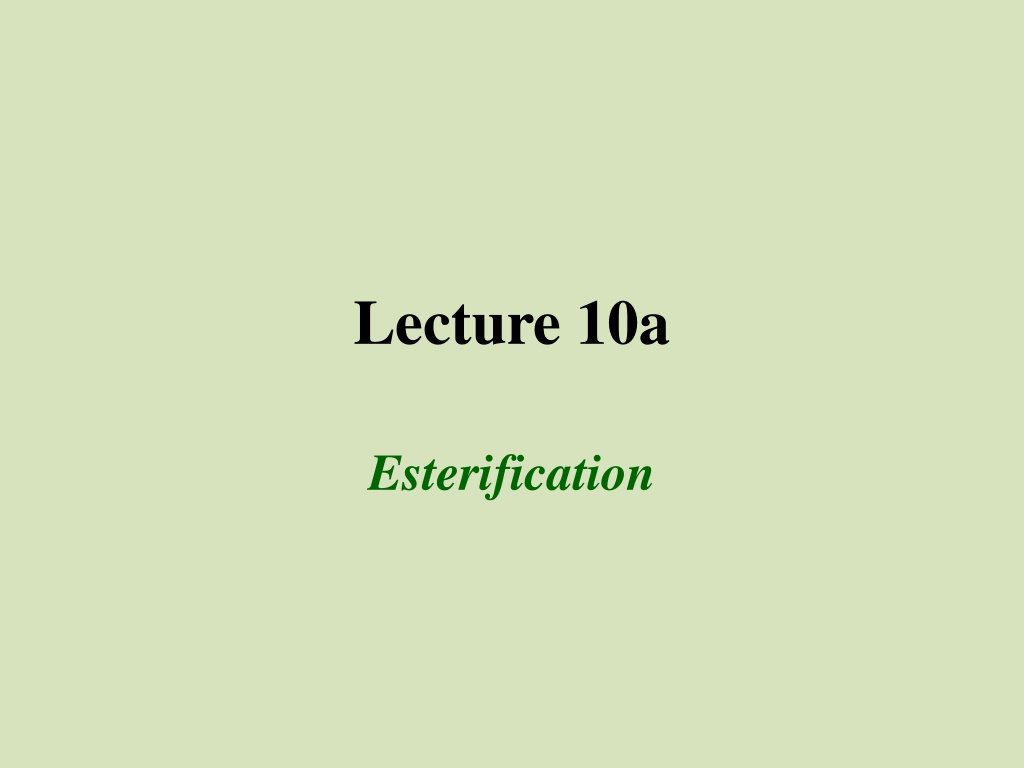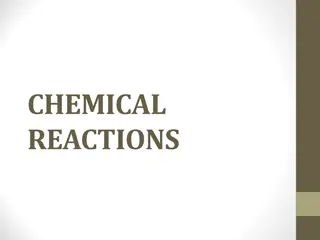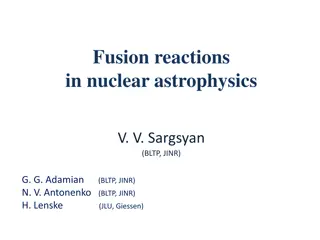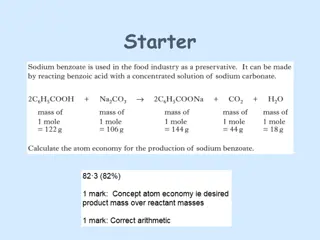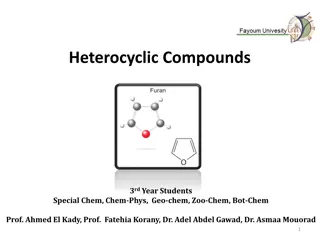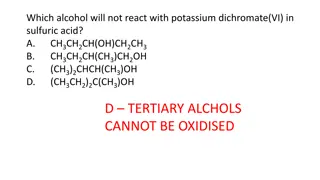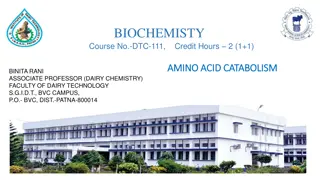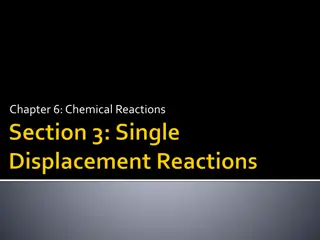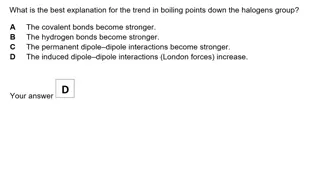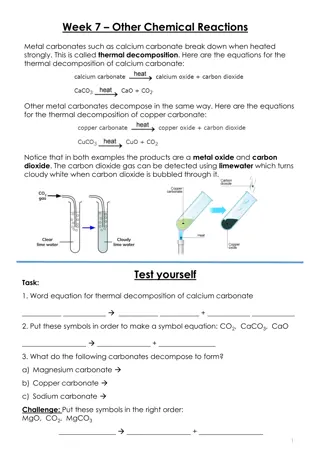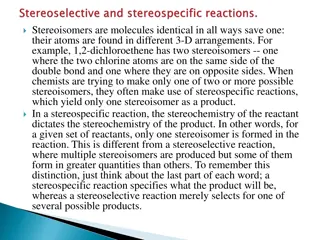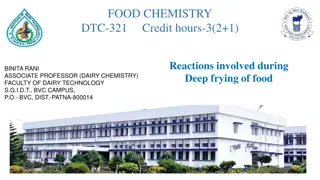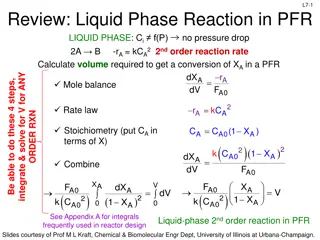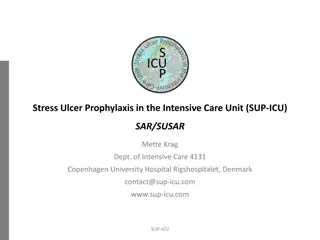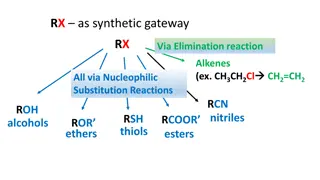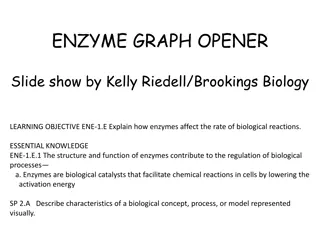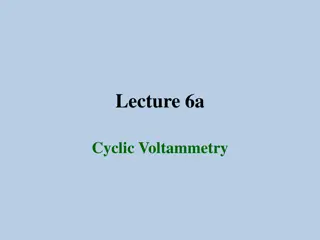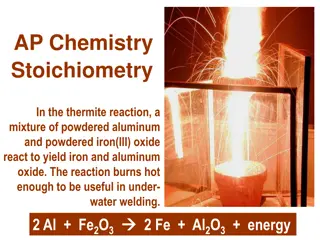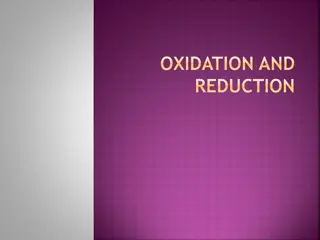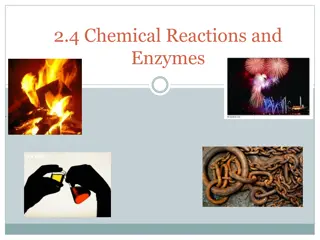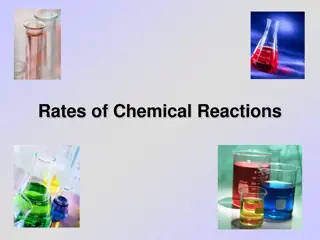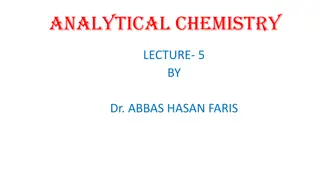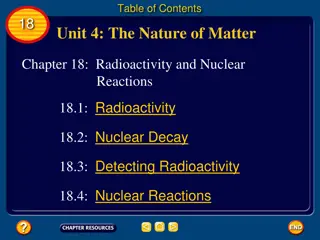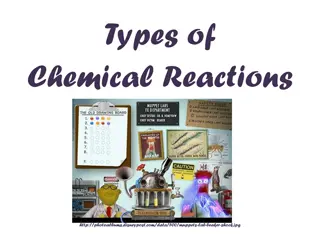Comprehensive Overview of Esterification Reactions
Esterification is a versatile chemical process to synthesize esters, involving various methods like Fischer esterification, Schotten-Baumann reaction, and Steglich esterification. Different reagents and catalysts are utilized for efficient ester formation, with considerations like reaction equilibrium, solvent choice, and exclusion of water. Experimental techniques such as refluxing and drying reagents are crucial for successful ester synthesis.
Download Presentation

Please find below an Image/Link to download the presentation.
The content on the website is provided AS IS for your information and personal use only. It may not be sold, licensed, or shared on other websites without obtaining consent from the author. Download presentation by click this link. If you encounter any issues during the download, it is possible that the publisher has removed the file from their server.
E N D
Presentation Transcript
Lecture 10a Esterification
Introduction Esters can be obtained by a broad variety of reactions Acyl chloride Accessibility of SOCl2 O O O SOCl2 OH Cl ROH/Pyridine -PyH+Cl- OR -HCl, SO2 Schotten-Baumann Esterification Anhydride Availability of anhydride O O O ROH/H+ ROH/H+ OR OH OR OR O -H2O O O O Methyl iodide CH3I is a carcinogen O O OMe KOH OH + CH3I DMSO Steglich Esterification DCC is used as reagent 4-Dimethylaminopyridine (DMAP) as catalyst DCU is the thermodynamic sink O H N H N N C N C + RCOOH + R'OH + RCOOR' 1,3-Dicyclohexyl- urea (DHU) 1,3-Dicyclohexyl- carbodiimide ( DCC)
Fischer Esterification I In the lab, a Fischer esterification is used for the synthesis of methyl benzoate It uses a carboxylic acid and an alcohol as reactants O O [H+] OR OH + ROH + H2O It is cheap method but suffers a low equilibrium constant (typically Keq~1-10, here: 2.3) Thus, the reaction requires special considerations to afford decent yields (Le Ch telier Principle) Either one or all products have to be removed from equilibrium An excess of one the reactants has to be used
Fischer Esterification II The reaction in the lab uses an excess of the alcohol The alcohol can act as the solvent and as a reactant The reaction usually uses an 4-10 fold excess The carboxylic acid is a solid and cannot be used in excess here because a heterogeneous reaction mixture would be formed A very strong mineral acid is used as catalyst The carboxylic acid is a weak electrophile The mineral acid protonates the carbonyl carbon atom and makes it a little bit better electrophile
Fischer Esterification III Other considerations Despite the addition of the catalyst, the rate of the reaction is still very low at room temperature Reflux the mixture to increase the rate of the reaction Water has to be excluded from the reaction right from the start because it is one of the products Very dry reagents (i.e., benzoic acid should be dried under the heating lamp) Dry glassware Keeping the reagent bottles closed when not in use because absolute methanol and concentrated sulfuric acid are hygroscopic
Experiment I Dry the benzoic acid thoroughly Why is this necessary? How is this accomplished? By placing it under the heating lamp Place the benzoic acid and methanol in a 25 mL RBF Add a few drops of conc. sulfuric acid Does the benzoic acid have to dissolve completely? How many drops of H2SO4are appropriate here? Why does this imply? Boiling and a reflux ring NO 4-5 drops Reflux the mixture for 60-75 min Why is the mixture refluxed for such a long time? What in the most efficient way here? Placing the flask in cold water Cool the mixture down What should not be observed here? A larger amount of a white solid
Experiment II Add ice-cold water to the reaction mixture Why is the water added? How much water is added? Until a clear phase separation is observed In which container should this step be performed? In which layer is the product? Usually the lower layer (PhCOOMe)=1.09 g/mL (15 oC) Centrifuge tube Remove the product Extract the aqueous layer with diethyl ether Why is the aqueous layer extracted with ether? To collect suspended product How much ether should be used here? 2* 2 mL
Experiment III What does the term combined organic layersrefer to? The combination of the product and the two ethereal extracts Extract the combined organic layers with sodium bicarbonate solution What is the purpose of this step? To neutralize the acids (PhCOOH, H2SO4) in the organic layer How much solution should be used for each extraction? 2 mL per extraction How often should this step be repeated? Until the CO2 formation ceases Dry the organic layer is dried over anhydrous sodium sulfate Remove the solvent using the rotary evaporator What is left at this point? A small amount of a tan colored oil
Characterization I Infrared spectrum Benzoic acid (C=O)=1689 cm-1 (OH)=2300-3300 cm-1 (C-OH)=1294 cm-1 (OH) Wet acid (C-OH) (C=O) Methyl benzoate (C=O)=1724 cm-1 (COC)=1112, 1279 cm-1 (absence of OH peak!) (C=O) s(COC) as(COC)
Common Mistakes The benzoic acid is not properly dried No concentrated sulfuric acid added Adding of too much concentrated sulfuric acid The reaction mixture is not properly refluxed The used glassware that is too large for the quantities handled Confusion about the layer containing the product Improper extraction of the benzoic acid Incomplete removal of methanol
